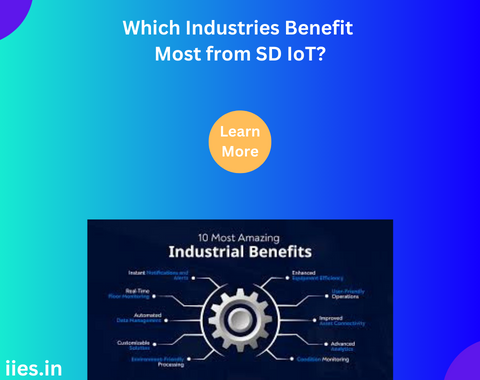
The integration of Software-Defined Internet of Things (SD IoT) has revolutionized various industries, enhancing efficiency, productivity, and connectivity. SD IoT amalgamates software-defined networking (SDN) and IoT technologies, enabling dynamic network configuration, enhanced security, and real-time data analytics. This article delves into the industries that have witnessed significant benefits from the adoption of SD IoT solutions, reshaping their operational landscapes and propelling them towards digital transformation.
1. Manufacturing Industry:
The manufacturing sector has been at the forefront of embracing SD IoT to streamline processes, monitor equipment performance, and ensure product quality. With SD IoT, manufacturers can implement predictive maintenance, where sensors embedded in machinery collect real-time data, allowing predictive analysis to identify potential failures before they occur. This proactive approach minimizes downtime, reduces maintenance costs, and optimizes overall equipment effectiveness (OEE). Additionally, SD IoT facilitates supply chain management by tracking inventory levels, optimizing logistics, and enhancing visibility across the entire supply chain network.
2. Healthcare Sector:
In the healthcare industry, SD IoT plays a pivotal role in enhancing patient care, improving operational efficiency, and advancing medical research. Connected medical devices, wearables, and IoT-enabled healthcare systems generate vast amounts of patient data, which can be seamlessly integrated and analyzed in real-time using SD IoT platforms. This enables healthcare providers to deliver personalized treatment plans, remotely monitor patients’ health conditions, and predict potential health risks. Moreover, SD IoT enhances hospital operations by automating processes such as inventory management, asset tracking, and facility maintenance, leading to cost savings and resource optimization.
3. Transportation and Logistics:
The transportation and logistics sector relies heavily on efficient supply chain management and real-time tracking to ensure timely delivery of goods and services. SD IoT solutions enable fleet management companies to monitor vehicle performance, optimize route planning, and enhance driver safety through real-time telemetry data analysis. Furthermore, IoT sensors deployed in warehouses and distribution centers provide visibility into inventory levels, temperature control, and shipment conditions, ensuring the integrity of goods throughout the supply chain. By leveraging SD IoT, transportation and logistics companies can minimize delivery delays, reduce fuel consumption, and improve overall operational efficiency.
4. Energy and Utilities:
The energy and utilities industry faces the challenge of balancing supply and demand while ensuring the reliability and sustainability of energy sources. SD IoT enables smart grid management by integrating IoT devices with utility infrastructure to monitor energy consumption, optimize grid operations, and detect faults or outages in real-time. Moreover, SD IoT facilitates the deployment of smart meters, allowing consumers to track their energy usage, optimize consumption patterns, and reduce utility bills. By leveraging SD IoT technologies, energy and utilities companies can enhance grid resilience, promote renewable energy integration, and mitigate environmental impact.
5. Agriculture and Agribusiness:
In the agriculture sector, SD IoT solutions offer transformative opportunities to optimize crop yields, conserve resources, and enhance sustainability. IoT sensors deployed in fields collect data on soil moisture levels, temperature, and crop health, enabling farmers to make data-driven decisions regarding irrigation, fertilization, and pest control. Additionally, SD IoT facilitates precision agriculture techniques such as drone-based monitoring, satellite imaging, and autonomous machinery, improving farm productivity and reducing operational costs. By harnessing the power of SD IoT, agriculture and agribusinesses can increase crop yields, minimize environmental footprint, and ensure food security for a growing global population.
6. Retail and E-commerce:
In the retail and e-commerce sector, SD IoT is reshaping customer experiences, optimizing inventory management, and revolutionizing supply chain operations. IoT-enabled smart shelves, beacons, and RFID tags enable retailers to track inventory levels, monitor product movements, and analyze customer behavior in real-time. This data-driven approach allows retailers to personalize marketing campaigns, optimize store layouts, and streamline checkout processes, thereby enhancing customer satisfaction and driving sales. Moreover, SD IoT facilitates last-mile delivery optimization, route planning, and order fulfillment, enabling e-commerce companies to offer faster and more efficient delivery services.
7. Smart Cities and Urban Development:
The concept of smart cities is gaining traction worldwide as urban populations continue to grow, and the need for sustainable, efficient infrastructure becomes imperative. SD IoT plays a crucial role in enabling smart city initiatives by integrating various urban systems, including transportation, energy, public safety, and waste management. IoT sensors deployed throughout the city collect real-time data on traffic flow, air quality, energy consumption, and public services usage, allowing city officials to make informed decisions to improve efficiency and enhance quality of life. For instance, smart traffic management systems leverage SD IoT to optimize traffic flow, reduce congestion, and minimize carbon emissions. Similarly, smart street lighting systems use IoT sensors to adjust lighting levels based on ambient light conditions and pedestrian activity, conserving energy and enhancing safety. By embracing SD IoT, cities can become more sustainable, resilient, and livable, fostering economic growth and social development.
8. Financial Services and Banking:
The financial services sector is undergoing a digital transformation, driven by technological innovations such as blockchain, artificial intelligence, and IoT. SD IoT solutions are revolutionizing banking operations by enhancing security, improving customer experiences, and enabling innovative financial services. For example, biometric authentication systems leverage IoT sensors to verify customers’ identities using facial recognition or fingerprint scanning, enhancing security and reducing the risk of fraud. Moreover, IoT-enabled devices such as smart ATMs and point-of-sale terminals offer seamless, personalized banking experiences, allowing customers to conduct transactions conveniently and securely. Additionally, SD IoT enables real-time monitoring of financial markets, fraud detection, and risk management, empowering financial institutions to make data-driven decisions and adapt to evolving market conditions effectively.
The integration of SD IoT is revolutionizing various industries, unlocking new opportunities for innovation, efficiency, and growth. From manufacturing and healthcare to transportation and agriculture, SD IoT solutions are reshaping operational landscapes, driving digital transformation, and delivering tangible benefits across diverse sectors. As technology continues to evolve, businesses must embrace SD IoT to stay competitive, adapt to changing market dynamics, and capitalize on the vast potential of interconnected systems and smart devices.
Indian Institute of Embedded Systems – IIES